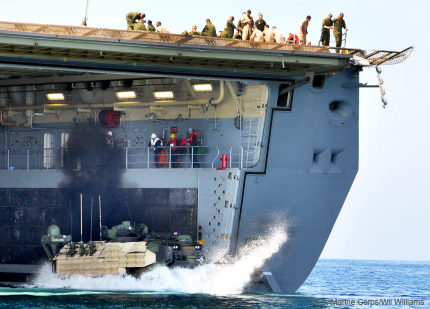Marines' Networking-On-The-Move takes to the waves
The mesh networking system, used on land since 2009, passes its first tests on water.

The NOTM-equipped amphibious vehicle arrives at the USS Anchorage.
The Marine Corps’ ability to create on-the-go mesh networks to support their expeditions now extends to the sea, after the first successful test of an amphibious command-and-control platform.
The Networking On-the-Move (NOTM) system, integrated onto the Assault Amphibious Vehicle, recently survived more than seven weeks of testing at Camp Pendleton, Calif., the Marines said.
“This gives the Marine Corps an amphibious command-and-control enabling capability that we never had before, particularly a network on the move, on the water,” Chris Wagner, lead engineer for NOTM, said in a release. “Existing amphibious command-and-control units don’t work on-the-move in terms of the network. This new capability allows them to keep moving—ship-to-shore.”
The NOTM-equipped Assault Amphibious Vehicle (AAV), which also carried a wideband-Ku satellite communications system, handled transmission such as email and tactical chat, as well as full-motion, real-time video from unmanned aircraft, giving everyone connected to the network a view of what’s on a beach or at sea.
“The success of NOTM is going to allow us to further develop expeditionary maneuver warfighting capabilities, not being reliant upon the capabilities that only exist thus far at the stationary Combat Operations Center,” said Maj. Keith Kovats, NOTM project officer. “We’re allowing the commanders to push the fight at a significantly higher tempo.”
Born of the Marines’ experiences in Iraq and Afghanistan, NOTM has been deployed with ground forces since 2009. On land, NOTM is based in two platforms—the Marines’ Humvee, known as the HMMWV, and the Mine-Resistant Ambush Protected All-Terrain Vehicle.
But operating on the water, where Wagner said communications can be “very iffy,” presented a different set of challenges. The tests, conducted by the Tactical Systems Support Activity and Amphibious Vehicle Test Branch, were designed to create realistic scenarios, to show the system could maintain connectivity in a variety of terrains, land-to-sea movements and ocean conditions, the Marines said. The AAV maintained the network while traveling extended distances over a variety of sea conditions, as well as while boarding and disembarking from the USS Anchorage, an amphibious transport dock ship.
Taking part in the tests were Marine AAV crewmen, NOTM operators and C2 operators, as well as developmental testers and engineers. The successful tests not only give the Marines a new command and control capability, but also increase the effectiveness of amphibious operations in hostile environments, the Marines said.
NEXT STORY: Army missile warning system advances




